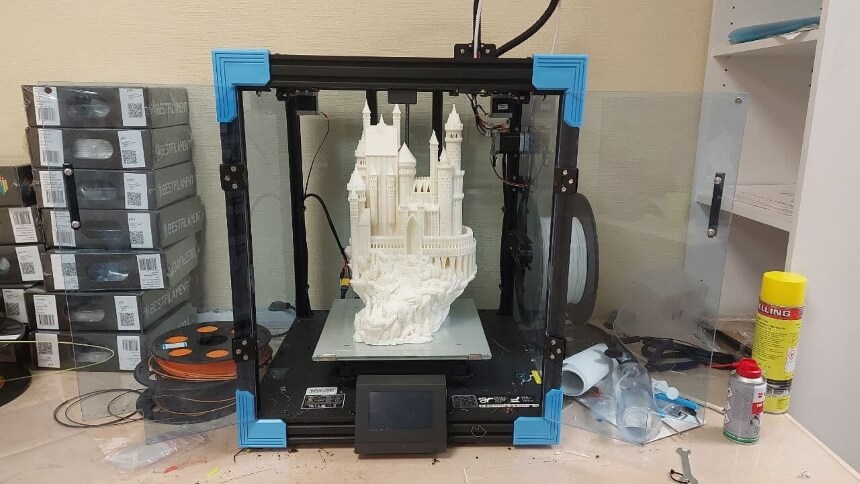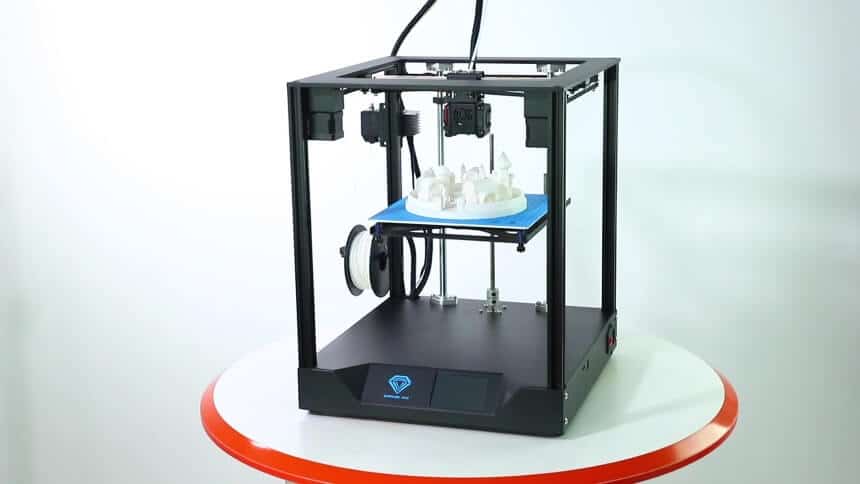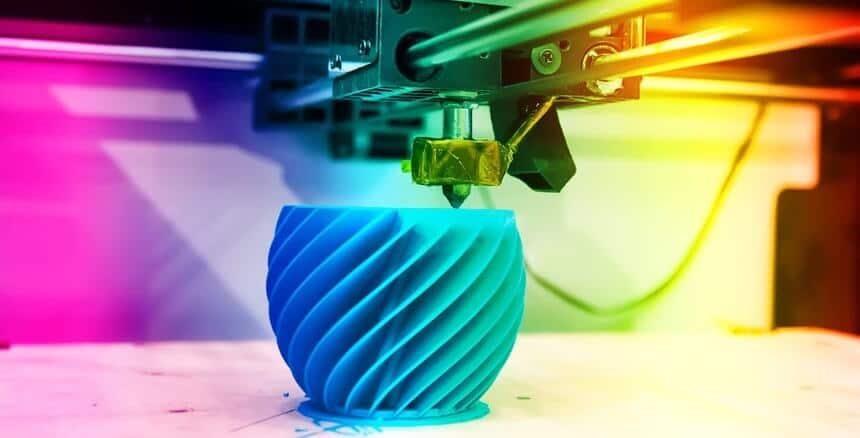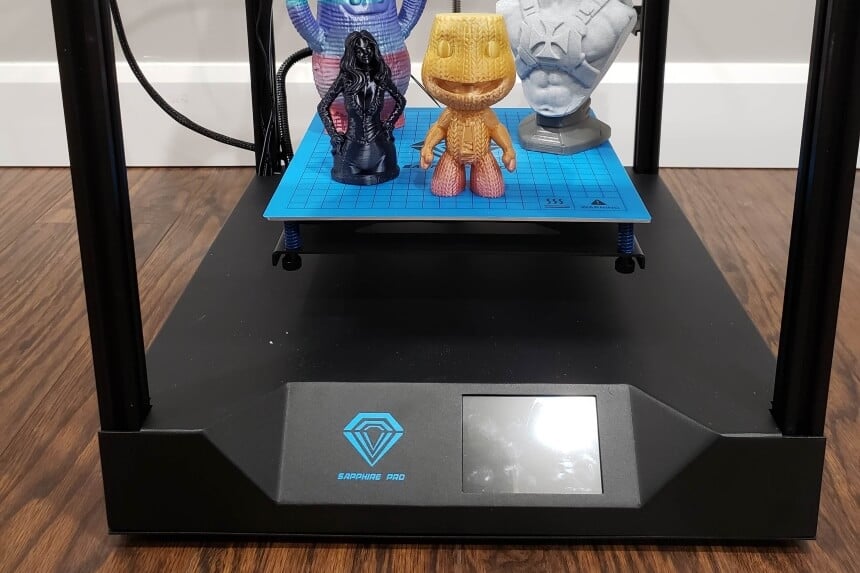

3D printers and their associated printing technologies are all the rage. They’re not only being used in industry but in home offices around the globe as well. By switching to 3D printing, fewer components need to be outsourced for manufacturing, simplifying the entire industrial process. As technology has evolved, so has the design system behind the original 3D process. Core XY 3D printers are revolutionizing the market with their speed, flexibility, and various cost benefits.
Our review today centers around 4 of the best Core XY 3D printers, providing you with a variety of outstanding options. The top place occupied the X5SA PRO 3D Printer. We’ve also included a useful buyer’s guide to accentuate the features you should take into consideration when you shortlist your choices. Printing speed, printing materials, and technologies, as well as printing size, will all help you identify the right printer for all your 3D printing requirements!
More features: 30P integrated cable; an ultra-high precision
The Core XY is ideally suited to experienced enthusiasts who have some skill in printer assembly. By using a Titan extruder, it can easily print a wider choice of consumables. Its 30P integrated cable wiring is not only simple but also convenient with its streamlined appearance. A 24Vpower supply heats the hotbed faster and keeps the temperature marginally more stable. If you’re looking for ultra-high precision and amazing stability, this is the printer for you!
This model comes as the range upgrades to the comparatively smaller X5. The frame is sturdier, providing a welcome change for units in this price category. The Core XY configuration does well at ensuring the Y and X-axis don’t move unnecessarily, which provides a more accurate and faster print.
More features: multi-language support; noise-reducing design; bed platform leveling; high-speed operation; power resume function
This particular model offers stable, silent, and high-speed operation. Not only does it have a hotbed platform leveling, but it also has a distinctive linear guide. A smoother print surface means there’s less noise. A double fan ensures there’s instant cooling of the workpiece. With a BMG two-wheel extruder, you’re guaranteed a more uniform and accurate discharge. A 3.5” touch screen supports multi-language interface operation.
A brilliant feature is the Core XY kinematics which allows it to print faster than other models. A faster print causes much fewer vibrations during printing. So, you’ll have a considerable artifact reduction such as ghosting and ringing. Improved accuracy is virtually guaranteed at higher speeds.
More features: large print area; continuous printing; high precision
The Ender 6 is an industrial 3D printer that features high precision printing and exceptionally high performance. It has superiority in thermal conductivity and heat resistance. The carborundum glass platform not only heats up faster, but the prints also adhere better. Your printed object will have extra smoothness right from the first layer.
A plus point is that this model is the upgraded version of the Ender 3 pro or v2. It achieves a printing speed of up to 150mm with a precision of 0.1mm. This is courtesy of the stable Core XY structure featuring the newer high-quality components. A definite way to make the printer excellent for larger print volume as well as continuous print!
More features: resume printing function; filament detector; direct-drive extruder; stable printing; built-in safe power supply
The Creativity Core XY Structure Elf 3D printer works on a precision dual Z-axis, which results in greater printing stability. It easily maintains exceptional printing quality. ELF also supports multiple filaments, including TPU, along with ABS and PLA. A filament detector will automatically pause the machine when the filament runs out. An alarm sounds to let you know that additional material needs to be added. So, there’ll be no waste of material or time. Exclusive ultra-quiet stepper drivers reduce the noise levels and allow for faster print speeds.
The ELF is commonly referred to as the best Core XY 3D printer kit because it’s equipped with a dual Y motor axis and a convenient down-shift Z-axis. This results in a significantly smoother move. It’s, therefore, easier to print more elaborate and extensive pieces. An added feature is that it can resume prints after an unexpected power outage. Not having to restart the project saves time and prevents resource wastage.
Opting for the quality of a Core XY printer is one thing. But selecting the right one for the job takes a considerable amount of research. Unlike the average Inkjet printer, one is not like the other. For the most part, the intended use will be the deciding factor in determining which features are more important than others.
Before you decide on a printer best suited to your printing and creating needs, it’s crucial to know how the Core XY technology differs from the original Cartesian 3D system. Read our Features section to determine what specifications you should consider when shortlisting your potential purchasing options.

In 2013 a new system was designed by MIT. On this new system, the belts move together in different planes. A change of movement drastically reduces the twisting impact while printing. Since the X and Y motors are kept in one place, the overall weight of the components on the printer is marginally reduced as well. The new design was called the Core XY 3D printer.
When you pull on the Core XY’s belt, it moves the tool head to a 45-degree angle. This is different from the original 3D printer in that the Cartesian system moves at either zero or ninety degrees. The Core XY has many functional advantages and is generally a better type of 3D printer.
Most people choose Core XY 3D printers for their accuracy, quality, and precision printing. However, there are several other features that should be reviewed before making the final buying decision. Let’s have a look at a few of the more significant features.
It might surprise you to know that a smaller print area often proves to be more reliable. The reason for this is quite simple. On the lower-end printers, it becomes easier to maintain better tolerances over a smaller area.
Once again, it depends on what you intend to print and how much experience you already have. For beginners, it might be better to start small. In fact, it might be better to focus on the quality of the printer rather than its size.
The Creativity Core XY Structure Elf 3D Printer, with its 300 x 300 x 350 mm printing size, is roughly the average size for these types of printers. A smaller alternative includes the Usongshine Two Trees 3D Printer Sapphire PRO printer, which has a printing size of 235 x 235 x 235 mm.

FDM is the more popular choice of technology on the Core XY 3D printers in our review. An example of this is the Creativity Core XY Structure Elf 3D Printer.

Be clear on what you want to use the printer for and what you intend to print. Ideally, you want a printer with a long compatibility list because this opens up possibilities for future projects.
The Creality Ender 6 3D Printer, for instance, can primarily only print on PLA. Whereas the X5SA PRO 3D Printer can print on a whole host of materials, including:
If you’re looking for faster print speeds without sacrificing the quality of the printed objects, then investing in a Core XY is definitely the way to go! Quite simply, this is achieved by having fewer moving components.
The bulk of many other 3D printers consist of a moving gantry with stepper motors that need to move around during the printing process. This type of movement causes vibrations which lead to issues with the printing of high-quality models.
On the other hand, a Core XY has stationary stepper motors. As a result, the print bed itself can only move vertically. The only component that moves with any substantial speed is the actual tool head.
This causes fewer vibrations which in turn minimizes the chances of poor-quality prints. The Creality Ender 6 3D Printer is a perfect example of a 3D printer with faster printer speed, which is essential to provide you with the quality prints you require.

Here it would depend on what you’re going to use the printer for as and who will be using it. If you’re adding the printer to a classroom setting, it’s got a printer with a universal interface.
Screens aren’t a crucial factor to the functioning of a 3D printer, but they facilitate running multiple printers, each on their own SD card. This frees up processing power on your computer.
Printers with touchscreen displays include the Usongshine Two Trees 3D Printer Sapphire PRO, the X5SA PRO 3D Printer, and the Creativity Core XY Structure Elf 3D Printer.
What the printer is made of will determine how sturdy it stands on the surface you have designated for it. You want a printer that won’t fall apart when you switch it on.
The Creality Ender 6 3D Printer on our review list is made up of a sturdy metal frame with acrylic glass covers on the sides. The Carborundum glass bed in the center forms the perfect surface to construct your printed object.
The Usongshine Two Trees 3D Printer Sapphire PRO is made up of a metal frame with a metal plate on which the object is created. Models such as the X5SA PRO 3D Printer are constructed using aluminum throughout.
The noise level of a 3D printer is a huge consideration, especially if you’re using it in a classroom or office environment. It’s important to note that no 3D printer is completely silent. However, some units are considerably quieter than others.
If you’re going to be using your printer in an area where the noise level should be considered, it’s important to check this feature before making your final decision.
Some ideas to help you reduce your printer noise include the following:
One user even suggested placing the printer in a huge box and reported a noise reduction of up to 50%! Another alternative would be to slow your printer speed down at night to avoid bugging any cranky neighbors. It’s important to check the noise levels advertised for each of the models you’ve shortlisted.
The Usongshine Two Trees 3D Printer Sapphire PRO model has a smoother surface which allows for less noise. A definite option to consider if the thundering sounds of your printer will be annoying you or the people around you.
We trust that our extensive review of the four best Core XY 3D printer options has given you the necessary insight into choosing the right printer for your 3D requirements. If you’re still on the fence about which option to choose, let’s recap our three favorites.
Firstly, we have our Editor’s Choice, the X5SA PRO 3D Printer, having a Titan extruder, it is capable of printing a wider choice of consumables.
Our second-best option, the Usongshine Two Trees 3D Printer Sapphire PRO because of its BMG two-wheel extruder that guarantees a stable and accurate print.
And lastly, the Creality Ender 6 3D Printer, our premium pick impressed us because of its ability to produce a larger print volume. The fact that it’s so easy to set up is a huge plus.
Ensuring you have the correct 3D printer will go a long way with printing exactly what you need. By investing in the best Core XY 3D printer, you’ll not only get the latest 3D printing technology, but you’ll also get more precise prints!